Get Your Free Mesothelioma Guide

Find a Top Mesothelioma Doctor

Access Help Paying for Treatment

Asbestos was used to make electrical panels and components. Examples include wire insulation, cable wraps and electrical paper. Asbestos wiring in electrical boards and panels reduced fire risk. Unfortunately, it posed a health risk to electricians.
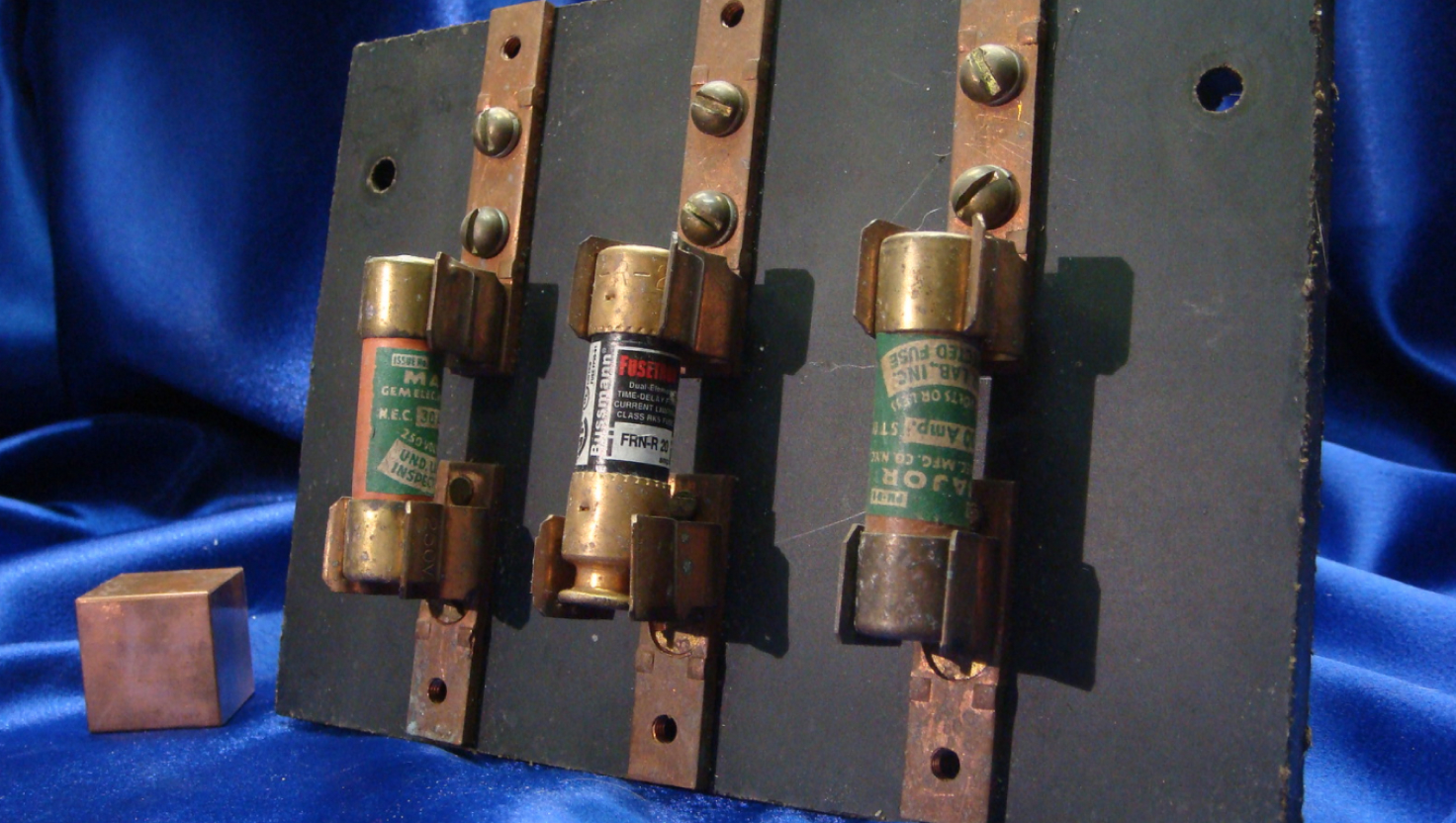
Since commercial electricity began, manufacturers have added asbestos to electrical panels. This material offered fire and electrocution protection. It also posed serious health risks to electricians and workers.
An electrical panel, or distribution box, is vital for managing a building’s electricity. It stops heat buildup that can cause fires or electrocution. In the early 1900s, with the rise of electricity in the U.S., manufacturers searched for safer materials.
Asbestos became popular for its heat and electricity resistance. It was affordable and easy to mix with other materials. Despite knowing the risks of asbestos dust in the 1930s and 1940s, companies kept this information secret. The link between asbestos exposure and diseases like asbestosis and mesothelioma wasn’t made public until the 1970s.
Ebonized Asbestos Panels
“Asbestos lumber” was a type of cement that contained asbestos. It was marketed as a fireproof, workable alternative to wood boards. Ebonized asbestos lumber was treated with a special compound to make it resistant to moisture as well.
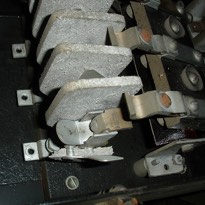
Asbestos Cement Electrical Shielding
Asbestos cement sheets could shield electrical components. Additionally, it could be crafted into arc chutes that enclose switch gear.
Molded Asbestos Cement Bases
Manufacturers often shaped asbestos cement to fit specific electrical components. This removed the need to install extra parts for shielding.
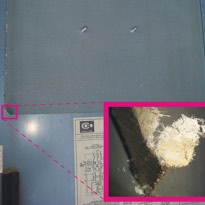
Asbestos Electrical Paper
Pieces of asbestos insulation paper, also known as flash guards, were used to line the inside of many electrical boxes. Asbestos paper products are prone to wear and tear. This increases the risk of asbestos exposure.
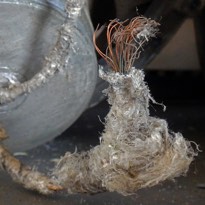
Asbestos Wire Insulation
Asbestos was used to make wires fireproof and insulated. However, frayed wiring can release dangerous fibers.
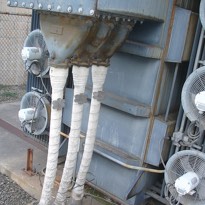
Asbestos Cable Wrap
Like pipes, thick electrical cables were sometimes wrapped in asbestos paper or cloth. This wrapping can degrade and crumble over time. Many electrical components were also made of molded asbestos plastic.
Get Your Free Mesothelioma Guide

Find a Top Mesothelioma Doctor

Access Help Paying for Treatment

Companies like General Electric and Westinghouse Electric made popular asbestos-containing electrical panel and wire insulation products.
| Manufacturer | Brand |
|---|---|
| General Electric | Deltabeston wires |
| Johns Manville | Ebony electric board, Electrobestos, Trancell, Vulcabestos |
| Siemens Energy & Automation | Bulldog, Murray |
| Turner & Newall | Sindanyo asbestos board |
| Union Carbide Corporation | Bakelite Panels |
Other manufacturers of these products include Allen Bradley, Cutler Hammer and Power Magnetics. Quin-T Corporation and Square D also made electrical products with asbestos.
In asbestos panel factories, workers mixed raw asbestos with tar, cement and millboard. This process created high levels of toxic dust. The amount of asbestos in mixtures varied. The finished products pose a threat to construction workers, electricians, homeowners and demolition crews. Sawing, drilling, sanding or breaking electrical panels can release asbestos fibers.
Simply replacing a blown fuse on an older electrical supply system can put electricians and those in other occupations in contact with crumbling asbestos materials. Do-it-yourselfers working on electrical panels in older homes also face the risk of exposure.
Microscopic asbestos dust is odorless and can cling to clothing. It may settle in the lungs permanently, causing damage. A 2022 health report noted that asbestos in electrical tapes and resin can also create dust.
Diseases Associated with Asbestos in Electrical Products
It is important to get medical advice from a doctor who specializes in your diagnosis. This may improve your chances of long-term survival.

Over $30 billion has been set aside to support those diagnosed with mesothelioma. We’ll help you explore your options and introduce you to the nation’s leading mesothelioma law firms.
Get Help NowElectricians have filed claims against asbestos manufacturers after developing mesothelioma. Both Westinghouse and General Electric have lost many workers’ compensation cases based on occupational asbestos exposure. Victims have received compensation through personal injury lawsuits and wrongful death lawsuits as well.
In many cases, mesothelioma compensation options are available through special trust funds for asbestos-related claims. In 1988, Johns Manville set up the first asbestos injury settlement trust. Many former asbestos companies have since followed this precedent in bankruptcy law.
An experienced mesothelioma lawyer can assess your case. They will see if you can file a lawsuit or claim trust funds. Other forms of compensation include VA claims, workers’ compensation, Social Security Disability, and treatment and travel grants.
Asbestos abatement often requires wetting areas to stop fibers from becoming airborne. However, this isn’t safe for electrical systems. Licensed workers must either use dry methods with special ventilation or ensure connections are turned off.
Dry methods for removing asbestos need approval from the U.S. Environmental Protection Agency. A licensed professional should abate asbestos electrical panels.
In the 1970s and 1980s, personal injury lawsuits revealed the dangers of asbestos. As a result, electrical panel manufacturers replaced the asbestos in their products. They used substitutes such as gypsum, calcium silicate, expanded perlite, cellulose and polystyrene.
By the 1940s, electricity was common in American towns and cities. Companies like Johns Manville had already made profits from asbestos cement and insulation. They also used asbestos in electrical panels and parts. Similarly, companies like Westinghouse Electric and Detroit Fuse and Manufacturing Company did too.
Recommended ReadingStay up-to-date on treatment, research, clinical trials, doctors and survivors
The information on this website is proprietary and protected. It is not a substitute for professional medical advice, diagnosis or treatment. Any unauthorized or illegal use, copying or dissemination will be prosecuted. Please read our privacy policy and terms of service for more information about our website.
This website and its content may be deemed attorney advertising. Prior results do not predict a similar outcome.
The Mesothelioma Center’s claim as the most trusted resource is based on our more than 150 5-star Google and BBB reviews. Our organization also helps more than half of all mesothelioma patients annually diagnosed.
Your web browser is no longer supported by Microsoft. Update your browser for more security, speed and compatibility.
If you are looking for mesothelioma support, please contact our Patient Advocates at (855) 404-4592
The Mesothelioma Center at Asbestos.com has provided patients and their loved ones the most updated and reliable information on mesothelioma and asbestos exposure since 2006.
Our team of Patient Advocates includes a medical doctor, a registered nurse, health services administrators, veterans, VA-accredited Claims Agents, an oncology patient navigator and hospice care expert. Their combined expertise means we help any mesothelioma patient or loved one through every step of their cancer journey.
More than 30 contributors, including mesothelioma doctors, survivors, health care professionals and other experts, have peer-reviewed our website and written unique research-driven articles to ensure you get the highest-quality medical and health information.
My family has only the highest compliment for the assistance and support that we received from The Mesothelioma Center. This is a staff of compassionate and knowledgeable individuals who respect what your family is experiencing and who go the extra mile to make an unfortunate diagnosis less stressful. Information and assistance were provided by The Mesothelioma Center at no cost to our family.LashawnMesothelioma patient’s daughter


Whitmer, M. (2025, January 13). Asbestos in Electrical Wiring. Asbestos.com. Retrieved December 14, 2025, from https://www.asbestos.com/products/electrical-panel-partition/
Whitmer, Michelle. "Asbestos in Electrical Wiring." Asbestos.com, 13 Jan 2025, https://www.asbestos.com/products/electrical-panel-partition/.
Whitmer, Michelle. "Asbestos in Electrical Wiring." Asbestos.com. Last modified January 13, 2025. https://www.asbestos.com/products/electrical-panel-partition/.
An occupational scientist or another expert who specializes in occupational hazards reviewed the content on this page to ensure it meets current scientific standards and accuracy.

Sean Fitzgerald, PG, is a research geologist specializing in asbestos environmental studies.
Our fact-checking process begins with a thorough review of all sources to ensure they are high quality. Then we cross-check the facts with original medical or scientific reports published by those sources, or we validate the facts with reputable news organizations, medical and scientific experts and other health experts. Each page includes all sources for full transparency.
Please read our editorial guidelines to learn more about our content creation and review process.
